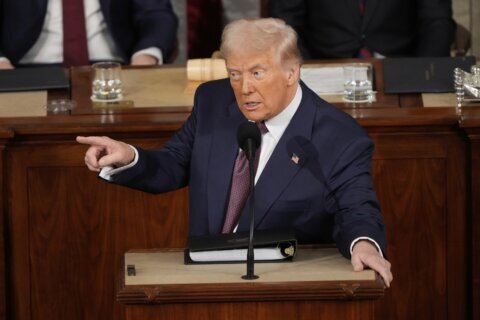In a frenetic digital world, it’s hard to think about long-term investments. But most research shows that actively trading your portfolio or trying to “time” the market is a losing proposition for most of us. Besides the obvious shortfall of not being experts, most of us also don’t have the resources to spend on expensive investment vehicles or trading fees.
[Sign up for stock news with our Invested newsletter.]
Long-term exchange-traded funds, or ETFs, provide a much more reliable — if unglamorous — approach, however. These “set-it-and-forget-it” funds tend to be diversified individually to smooth out any short-term volatility. Furthermore, when you bundle two or three of them together, you get a well-rounded portfolio that is likely to withstand the test of time.
You should always do your own investment research, and there really is no such thing as a one-size-fits-all approach to Wall Street. And although patience often pays off, there are indeed times when you have to cut your losses and change your strategy.
However, most investors will likely find this list of long-term ETFs appealing, thanks to the simplicity and reliability they offer:
| Long-term ETF | 5-year return |
| iShares Core S&P 500 ETF (ticker: IVV) | 11.41% |
| Invesco S&P 500 Equal Weight ETF (RSP) | 9.77% |
| Schwab U.S. Small-Cap ETF (SCHA) | 4.86% |
| Vanguard Information Technology ETF (VGT) | 18.78% |
| iShares Core Dividend Growth ETF (DGRO) | 11.11% |
| iShares iBoxx Investment Grade Corporate Bond ETF (LQD) | 2.14% |
| Vanguard Total International Stock ETF (VXUS) | 2.78% |
iShares Core S&P 500 ETF (IVV)
The S&P 500 is the most widely respected index of U.S. stocks, and for good reason. It’s not as narrow as the Dow Jones Industrial Average, which only has 30 components, and it’s not quite as tech-heavy or volatile as the Nasdaq. IVV is a simple way for investors to gain exposure to large domestic stocks, with 500 components that mirror the index itself.
Although it’s “only” the second-largest ETF by assets, this S&P 500 fund commands more than $300 billion. At 0.03% in annual expenses, or $3 on every $10,000 invested, it’s cheaper than the largest option, the SPDR S&P 500 ETF Trust (SPY), which charges more than three times that amount. In the long run, keeping your expenses down is just as important as performance, so IVV wins out.
[READ: 9 of the Best Mutual Funds to Buy Now]
Invesco S&P 500 Equal Weight ETF (RSP)
Of course, it’s worth noting that the S&P 500 is weighted by market value. That means bigger stocks — mainly in the tech sector — carry a lot more weight than smaller ones. For instance, right now the S&P 500 has more than 14% allocated to two Silicon Valley giants alone — Apple Inc. (AAPL) and Microsoft Corp. (MSFT).
If you don’t like this bias toward the big guys, RSP looks to allocate the portfolio mostly equally around all 500 components through regular rebalancing. In the very long run, that may add a layer of diversification that many investors find attractive. But keep in mind that sometimes, putting your eggs in fewer baskets pays off. The broader S&P 500 is up about 10% so far in 2023, while RSP is only up by low single digits.
Schwab U.S. Small-Cap ETF (SCHA)
If you’d rather skip over big stocks entirely, this Schwab ETF owns smaller companies that carry a bit more risk but could be tomorrow’s leaders if their growth plans pan out. Generally, holdings of SCHA are valued at less than $10 billion in market value. The portfolio includes lesser-known tech stocks, such as Lattice Semiconductor Corp. (LSCC), racetrack operator Churchill Downs Inc. (CHDN) and grocery food-service operator Performance Food Group Co. (PFGC).
There’s a bit more risk in smaller names like this, particularly if the economy takes a spill, but in the long run small caps tend to pick themselves back up. Besides, a long list of about 1,750 holdings means your cash is spread around the lesser-known names on Wall Street, so one single company’s troubles won’t sink the ship.
Vanguard Information Technology ETF (VGT)
If the long-term growth potential of smaller companies appeals to you, then it may be worth checking out a dedicated tech-sector fund like VGT. This Vanguard ETF is wholly dedicated to tech stocks, with 100% of assets in that sector. There are more than 360 positions in this fund, though familiar giants Apple and Microsoft top the list. VGT is by far the largest technology-focused sector fund on Wall Street, with more than $50 billion in assets under management. So if you want a simple and easy way to play the broad trends in technology over the long haul, then VGT is worth considering.
[READ: ETF vs Mutual Fund: How to Choose for Your Investing Strategy]
iShares Core Dividend Growth ETF (DGRO)
If you’re really after long-term returns, then you should consider income-oriented investments that include dividend stocks. That’s where DGRO comes in, with a diversified portfolio of more than 400 stocks that include some of the most stable and established brands on Wall Street, including health care icon Johnson & Johnson (JNJ), megabank JPMorgan Chase & Co. (JPM) and others.
It’s not just focused on dividend stocks, however, but also on dividend growth over time. So while the current yield is about 2.5% — much better than the roughly 1.7% yield for S&P 500 components, on average — the gap will widen in the long run as these dividend growers increase their payouts in the future.
iShares iBoxx Investment Grade Corporate Bond ETF (LQD)
If income is really what you’re after, consider this bond fund from iShares that provides exposure to a wide variety of investment-grade corporate debt. This means you won’t find risky junk bonds from troubled stocks; instead, you’ll rely on well-established and stable companies, such as brewing giant Anheuser-Busch InBev SA/NV (BUD), CVS Health Corp. (CVS) and Goldman Sachs Group Inc. (GS), to name a few.
In a rising-rate environment, bond funds like this can take a hit, but with the current yield now about 5.2%, it’s safe to say a lot of the rate increases are now priced in. Besides, in addition to the yield you will have much-needed diversification into another asset class via this bond fund — and that diversification is a hallmark of any good long-term portfolio.
Vanguard Total International Stock ETF (VXUS)
Speaking of diversification, it’s important to look beyond domestic-focused ETFs to layer in geographic variety in your portfolio, too. That’s what this Vanguard fund provides, offering exposure to the largest stocks in developed markets such as Japan (15% of assets) and the U.K. (9%), as well as emerging markets like China (8%). That means a portfolio built on big multinational names you probably recognize, including chipmaker Taiwan Semiconductor Manufacturing Co. Ltd. (TSM), Swiss consumer products icon Nestlé SA (NSRGY) and big pharma mainstay Roche Holding AG (RHHBY).
While the U.S. stock market is a very good bet in the long run, you still may want to consider this international ETF to round out your holdings and provide stability in the years ahead.
More from U.S. News
What Is Preferred Stock, and Are Preferred Shares a Good Fit for You?
7 Best Funds to Hold in a Roth IRA
U.S. Debt-Ceiling Deadline 2023: What Investors Should Know
7 Best Long-Term ETFs to Buy and Hold originally appeared on usnews.com
Update 05/31/23: This story was previously published at an earlier date and has been updated with new information.







